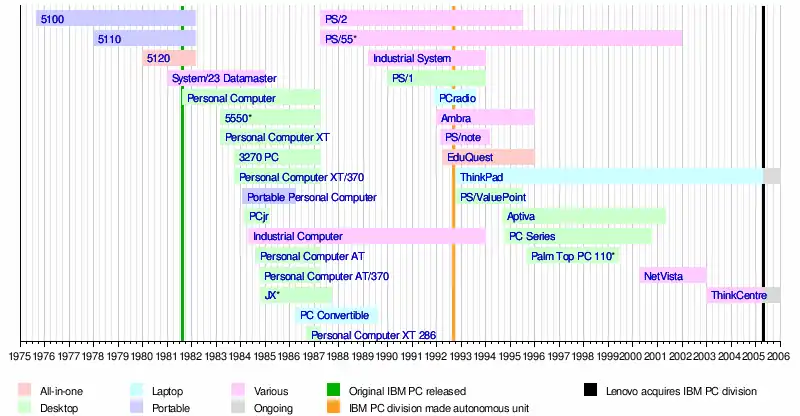 | |
| Manufacturer | IBM |
|---|---|
| Type | Professional Computer |
| Release date | February 1980 |
| Introductory price | US$13,500 (equivalent to $47,900 in 2022) |
| Media | 2 × 8-inch 1.2 MB floppy disk drives |
| Operating system | APL, BASIC |
| CPU | IBM PALM processor |
| Memory | 16–64 KB RAM (with 16 KB iterations) 64 KB ROM |
| Display | 9-inch CRT |
| Input | Keyboard |
| Mass | 45 kg (99 lb) |
| Predecessor | IBM 5110 |
| Successor | IBM Datamaster |

The IBM 5120 Computing System (sometimes referred to as the IBM 5110 Model 3) was announced in February 1980 as the desktop follow-on to the IBM 5110 Computing System. It featured two built-in 8-inch 1.2 MB floppy disk drives, 9-inch monochrome monitor, 32 KB RAM and optional IBM 5114 stand-alone diskette unit with two additional 8-inch 1.2 MB floppy disk drives.[1] The system was sold with both APL and BASIC languages in ROM and provided a toggle switch on the front panel to select the language. APL allowed numerous business software written on IBM minicomputers to run on the 5120.[2]
Description
It was launched in 1980 as the lowest-priced IBM business computer to date. Depending on the options the overall system prices ranged from $9,340 to $23,990. To emphasize its office image IBM released in that same year 6 new programs: task inventory, billing, payroll, accounts payable, accounts receivable and general ledger accounting.[1]
Aside from larger screen size and performance benefits over its predecessor, the IBM 5120 design incorporated several usability advantages:
- Reduced 'footprint' requiring less desktop space
- Reduced glare on monitor, keytop and product surfaces
- Ease of handling/lifting based on bottom form treatment
- Reduced static loading in arms and shoulders due to keyboard palm rest
For its usability features and appearance, the IBM 5120 was recognized with two major industrial design awards and described with terms such as "clean, well thought out"; "subtle detailing shows great care in execution"; and "looks like quality″.[3][4]
IBM did not offer a LAN or hard disk drive for these systems. However, in 1981, Hal Prewitt, founder of Core International, Inc, invented and marketed the world's first and only hard disk subsystems and "CoreNet", a LAN used to share programs and data for the IBM 5110 and 5120 systems.[5][6] In 1984, Core introduced PC51, software that allowed 5100 Series computer programs written in BASIC to run unmodified on the IBM PC and compatibles under PC DOS and share programs and data on CoreNet, the LAN for all these models.
Timeline
| Timeline of the IBM Personal Computer |
|---|
 |
| Asterisk (*) denotes a model released in Japan only |
References
- 1 2 "IBM 5120 Computing System". IBM Archives. Archived from the original on 10 November 2011. Retrieved 19 October 2011.
- ↑ "IBM 5120 Computing System". Old-Computers.com Museum. Archived from the original on 2010-11-20.
- ↑ ″Annual Design Review". I.D. Magazine, Product Design Award: IBM 5120 Computing System, Tom Hardy: Industrial Designer, 1981.
- ↑ "Industrial Design Excellence – Gold IDEA". Industrial Designers Society of America, Product Design Award: IBM 5120 Computing System, Tom Hardy: Industrial Designer, 1980.
- ↑ "Save IBM 5110/20 from junk yards of the world" (PDF). Core. Archived from the original (PDF) on 21 July 2011. Retrieved 31 March 2010.
- ↑ "1982 CORE Newsletter" (PDF). Core. Archived from the original (PDF) on 19 November 2016. Retrieved 18 Nov 2016.
- "Core 5110/20 Hard Drives" (PDF). Archived from the original (PDF) on 19 November 2016.
- "1984 Core PC51 Users Manual" (PDF). Archived from the original (PDF) on 19 November 2016.
- "1984 Core PC51 Media Release" (PDF). Archived from the original (PDF) on 19 November 2016.